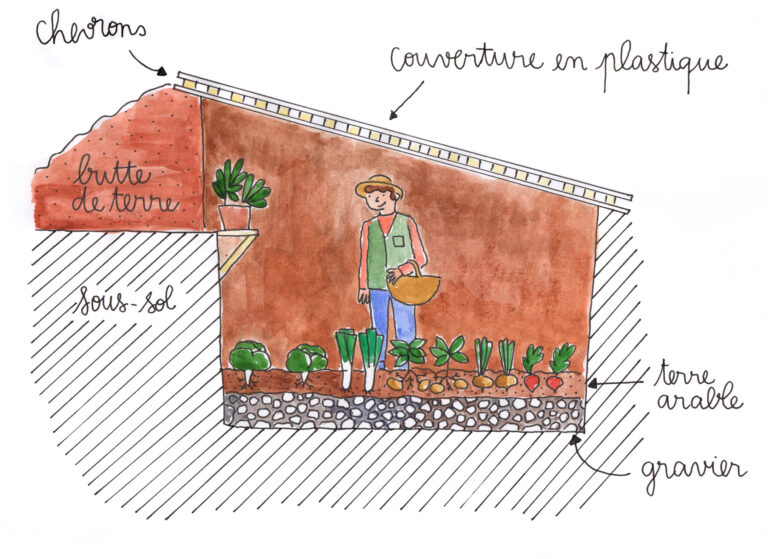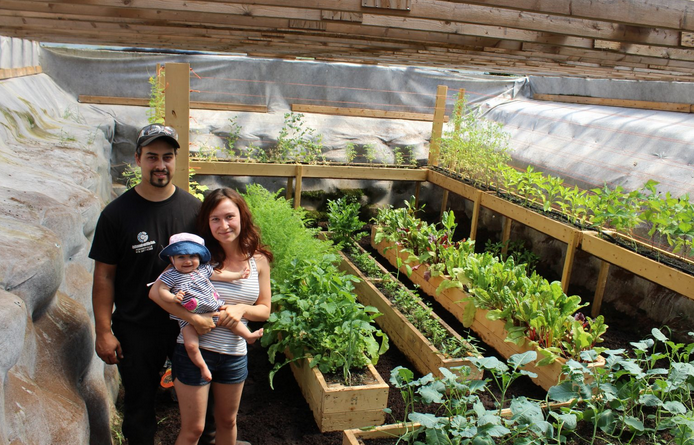Growing plants year-round, especially in cold or unstable climates, can be a real challenge. However, an underground greenhouse, also called a “walipini” or “pit greenhouse,” offers a sustainable solution. Using the natural insulation of the earth, these greenhouses ensure more stable temperatures, protect plants from the elements, and extend the growing season.
1. Advantages of an underground greenhouse:

• Thermal stability : The soil has natural insulating properties. Even a few meters below the surface, the soil maintains a relatively stable temperature.
• Protection from the elements : Underground greenhouses are less exposed to wind, snow and hail, reducing the risk of damage.
• Extended growing season : The stable environment allows cultivation even in the cooler months.
Sustainability : Thanks to their natural insulation, these greenhouses use less energy for heating.
2. Choose the right location:

• Sun exposure : Choose a location with maximum sunlight. South-facing is ideal, north-facing in the Southern Hemisphere, north-facing in the Southern Hemisphere.
• Drainage : Ensure the site has good drainage to prevent water from pooling. Use raised beds or gravel paths to promote drainage.
• Accessibility : Choose a location that is easily accessible all year round.
3. Build the underground greenhouse:
a. Excavation :
• Depth : Dig to a depth of approximately 2.5 to 3 meters to benefit from soil insulation. Depth may vary depending on the frost line in your area.
Dimensions : Customize the size as needed. A standard size is 3×6 meters, but adjust it to fit the available space.
b. Walls :
• Build the walls out of bricks, stones, or bags of earth. Reinforce with concrete if necessary.
• Insulate the north-facing wall to retain heat. Use straw bales, foam insulation, or other insulating materials.
c. Roof :
• Use UV-resistant plastic, polycarbonate sheets or glass for the roof.
• Ensure the roof is sloped to allow maximum sunlight and facilitate the flow of rain and snow.
d. Soil :
• Gravel soil can improve drainage. You can also opt for concrete or maintain a natural soil, depending on your preference.
e. Ventilation :
• Install vents or windows on the roof or at the top of the pitched roof to allow warm air to escape.
• Add a door at each end of the greenhouse to promote air circulation and improve accessibility.
4. Maintain the underground greenhouse:
• Monitoring : Check temperature and humidity regularly. Consider installing a thermostat.
• Pest Control : The unique design of an underground greenhouse can make it more susceptible to certain pests. Inspect regularly and use natural repellents.
• Irrigation : Adjust your watering schedule based on plants and humidity. Too much water can cause drainage problems.
5. Additional tips:

• Water barrels : Place water barrels in the greenhouse. They absorb heat during the day and release it at night, helping to stabilize temperatures.
• Raised beds : The use of raised beds can prevent waterlogging and root rot.
• Reflective surfaces : Place reflective materials on the walls to maximize light distribution.
Conclusion:
An underground greenhouse can be a sustainable and fantastic solution for growing plants year-round. While it requires some initial effort and investment, the rewards, such as fresh produce even in winter, are worth it. Be sure to maintain and inspect your greenhouse regularly to ensure the best growing conditions for your plants.
How to build an underground greenhouse


